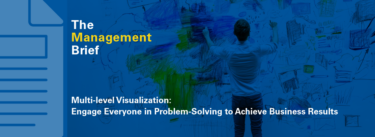When I ask this question in my A3 / Problem Solving classes across various industry groups in the U.S, many of my students give me a few peculiar looks, while a few recognize it as something they try to embed into their thinking process.
Being SMART is about paying attention to the five qualities of this acronym, and is necessary to create a solid A3 story using PDCA thinking by following a specific questioning process at the gemba. Remember that the A3 is a tool and it’s always important to follow the “thinking” behind the tool. As John Shook shared in Managing to Learn, “the A3 is only as good as the dialogue that creates it”. So be SMART, generate good dialogue, and you will end up with a strong culture of understanding gap to standard.
So what does SMART stand for you may ask? The following qualities:
S- Specific
M-Measurable
A- Attainable-Achievable
R- Realistic
T- Timely
When you are out at the gemba using the problem solving process to create your A3s you must go process the actual work that is happening, gather facts, involve the team members doing the work, and remember your SMART goals within each step.
Specific
- You may ask yourself what you are trying to accomplish in your problem solving activity?
- Ask why you’re trying to accomplish it, and how it relates to the company. (Purpose)
- How you are going to accomplish it? (How much and by when)
- Don’t use vague words like some, many, few, a couple. When a good trainer comes across these fuzzy terms they will always ask you, “What does that mean?” “How do you know?”
Measurable
One of the first things my Japanese trainers taught me in Problem Solving was, “Tracey-san, “if you can’t measure, don’t do it”. His actual words were, “no measure no do” because he was learning English. I often use that short phrase in my sessions and it actually sticks in participants minds at the end. If you can’t quantify your GAP, then how do you know how effective your countermeasures are addressing the root cause?
Part of being specific is determining a quantifiable gap in framing your problem; therefore you are measuring on the right side of the A3 if you are addressing the root cause. I use a process called “reading in reverse”, which is a great way to determine the measurability of your countermeasure back to your gap. Here are the series of questions to read your A3 in reverse:
- Did your countermeasure address the root cause?
- Did addressing your root cause allow your process to flow without the point of occurrence(s) or issues?
- By improving the process did you address the prioritized problem you had broken down in your gap?
- Did you meet the target you projected for this prioritized problem?
- How much of the gap did you eliminate by addressing this portion of the gap?(Note some problems need to be broken down into manageable pieces)
- Did you improve a company key performance indicator by solving this portion of the problem?
By asking these questions back through the A3 you can test the logic of each stage of the A3 to determine it was based on facts, not assumptions and prove measurability.
Attainable
How are you setting your goals when your problem solving? Are they within your control or influence? Do you involve your stakeholders when making the decision? Are you relating/aligning them to a key performance indicator within the company? (Quality, Safety, Productivity, Cost).
When you set the targets/goals they need to be attainable with a slight “stretch” to them, ensuring you are always thinking about continuous improvement or raising the bar on yourself. I often see folks set very challenging targets without understanding all the processes involved. It’s not out of the ordinary to adjust the targets once we learn more about the process involved and how it could affect others as we progress.
Realistic
Some may refer to this as “do-able”. It’s not realistic to set goals that can’t be met due to lack of resources or possibly skill set at the time. You want the Problem solving experience to “push” or “stretch” someone as they are learning, but not frustrate them to the point of giving up. Sometimes there is a fine line. It is up to the mentor to assist with what is “do-able” at times by knowing their people. As a leader I try to always understand my people and know that a “seasoned” problem solver could be up to a challenging problem, versus a novice tackling that type of issue. We may often find ourselves at a dead end path of a design change or material change. Those issues would need further discussion with stakeholders to fully understand what is involved and potentially undergo a cost benefit analysis. The last thing you want is to spend non-value added time on such a problem, which is why it’s good to have good discussion ahead of time (nemawashi- consensus, buy-in, sharing of information)
Timely
Set a proper time-line for the goal or a target, for example by the end of the week, year, month, in 3 months, 90 days etc. Coming up with a solid goal gives you a time-line to work with.
If you don’t set a time, the commitment becomes too nebulous, or it tends not to happen because you feel you have forever to solve the problem. Without a time limit, there’s no urgency to start taking action now. This could go back to being specific as well. Why are you solving this problem? What will happen if the problem isn’t solved? Is it affecting a worker in a negative way? These type of questions help guide us to setting challenging timelines.
Time-lines must ALSO be measurable, attainable and realistic.
So in closing everyone can benefit from goals and objectives if they are SMART about them when they are problem solving. This can take place as an individual as well as groups working together. So the next time someone asks you if you’re SMART you can say, “As a matter of fact–I am”….
Problem Framing Skills
Improve your ability to break down problems into their specific, actionable parts.






